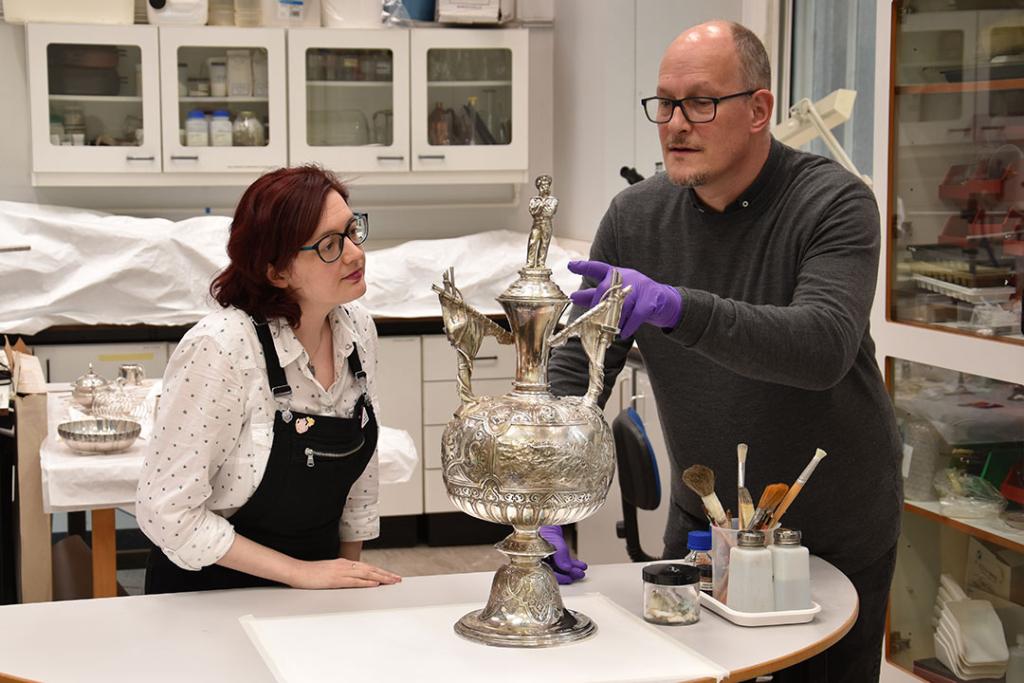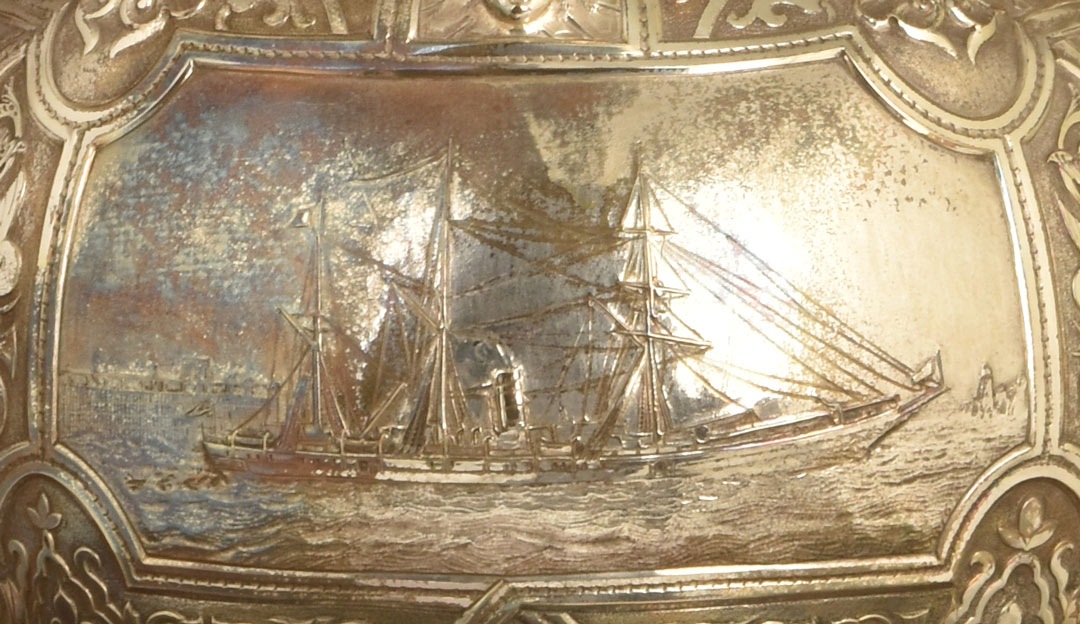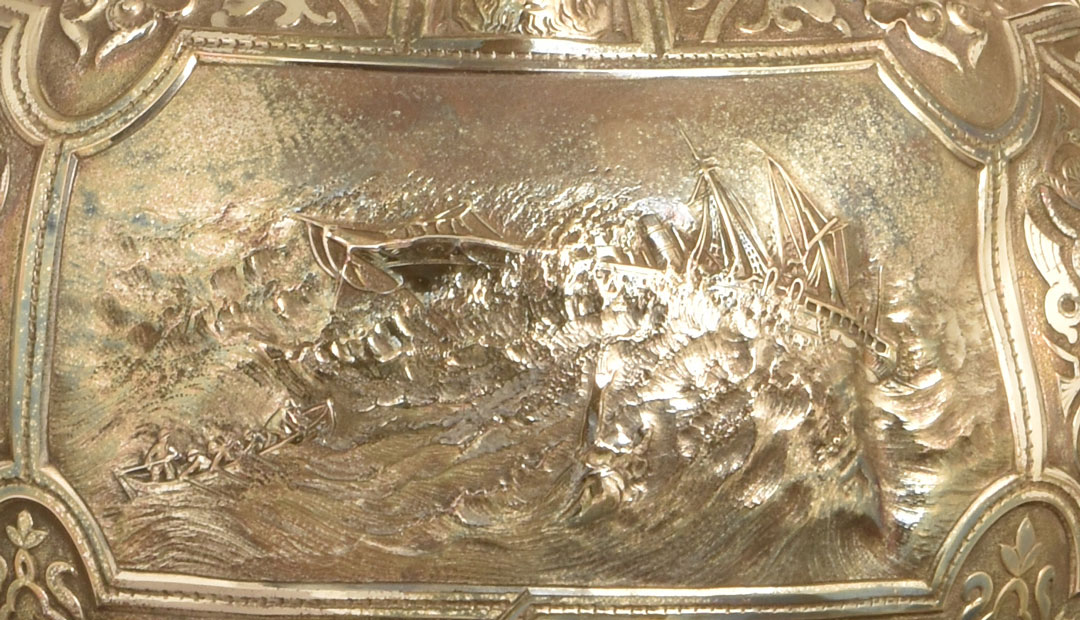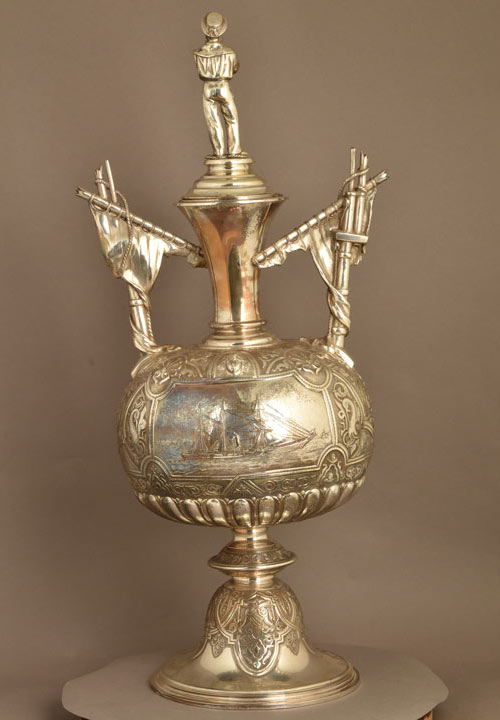Plimsoll cup shines again
Take a look behind the scenes at the conservation work that went into preparing one of the objects for display in our Life on Board gallery.

My favourite place to visit across all of National Museums Liverpool’s many venues, stores, and archives, is the Conservation studios. There’s nothing quite like seeing one of our treasured objects get its very own ‘Cinderella’ moment.
In the photo above you can see Metals Conservator Steve showing me his work on the Plimsoll Cup, an object that I’m very fond of as it combines beautiful silverwork with an emotive human, and political, story that’s still playing out today. If you look at the right side you can see the tarnish has all been cleaned away, whereas the left is still awaiting treatment.
The Plimsoll Cup was presented to Liberal MP Samuel Plimsoll by unionised Liverpool seafarers in 1876 to mark the passing of the Merchant Shipping Act. They’d raised the funds for it themselves to express their gratitude for his long campaign for improvements in Seafarers’ welfare. Plimsoll is best remembered for campaigning for the safe loading line (or Plimsoll line - and yes, that’s where your shoes got their name!) on a ship, but he was concerned with all aspects of seafarers’ health and wellbeing. Plimsoll’s nickname of the ‘sailor’s friend’ was well earned as he worked across political divides to improve conditions for those working at sea.
When I first saw this cup in our stores, I remember carefully unwrapping it from protective Tyvek cloth to reveal a magnificent piece of work. I was delighted by the detail, the broken ship masts that formed the handles, the seafarer stood proudly on top, and the two very different seascapes on the front and back. It was in need of a little TLC, it was tarnished and had a distinct lean to it, but its potential was clear to see.

The cup uses the technique of repoussé and chased decoration (where the rough image is beaten through from the reverse side and detail added with fine punches from the front) to present a ship both in calm and in storm. Note the particularly grim hand reaching out of the waves in the image below.

Plimsoll's campaign
We were keen to include the cup in our Life on Board gallery as part of a display talking about Plimsoll’s campaign and its importance in the history of safety at sea. As his biographer Nicolette Jones wrote:
"Plimsoll’s load line has been a UK standard for nearly 120 years, and a global standard for about 80. If we take his own estimate that 400-500 lives a year were lost from preventable causes on British ships alone, his measure has since protected hundreds of thousands... the sea is even now a safer place."
The Plimsoll Sensation, 2006
Some of the other points Plimsoll campaigned on, such as better quality food for seafarers, are still raised as key issues in their wellbeing today by international organisations such as ISWAN. In particular though Plimsoll’s determination to change people’s attitudes to seafarers, pressing for them to be acknowledged as highly skilled people doing an often dangerous and essential job, now feels poignant in a way we could not have predicted when selecting objects for the gallery. Further proof that Plimsoll’s campaign has never lost its relevance.
Conserving the Plimsoll Cup
As an object our cup's not just a thing of beauty but a physical representation of how Plimsoll and his campaign were received by the very people he worked so hard for. It was given its own pride of place in the gallery, accompanied only by a small commemorative medallion. Set against a striking red backdrop the silver cup could command the attention it deserved, but it fell to our Metals Conservator, Steve Newman, to help it shine.
When Steve was working on the cup he talked me through his work to remove the tarnish and try to right its sideways lean.
"The treatment used different fine powders in aqueous pastes and dry in silicon rubber compounds to delicately remove the tarnishing without scratching or over-polishing. The cup was degreased and further cleaned with solvent swabs before applying a protective lacquer coating to prevent re-tarnishing. The body of the cup was slightly askew on its stem and after careful examination it was re-straightened. Other damage, such as small dents, remain as these would have been very tricky to remove without damage to the repoussé and chased decoration in those areas."

Before treatment

After treatment
The importance of conservation
The very nature of conservation means that unless you see the before and after you might never know just how much work and skill has gone into readying an object for display. The best conservation work is work you’d never know had needed to be done. Interventions are sympathetic and repairs often completely invisible to any but the most expert of eyes. A more philosophical business than simple restoration, conservation isn’t an attempt to show an object exactly as it would have been when brand new but to stabilise, clean and repair the historic material while attempting to retain the signs of use and wear through time. As we see here with the dents in the cup, sometimes it’s better to leave some damage alone. In conservation it feels like it’s as important to know when to stop as when to act.
Everything you see in our galleries will have passed through the Conservation department at some point in its time with National Museums Liverpool. Some objects will have stopped there only for a condition assessment and light clean, while others will have undergone hours of meticulous treatment. It’s our Conservation team that help us to preserve our collections so that future generations will be able to enjoy them as much as we do. It’s an unending fight against time and decay, involving a high level of attention to detail and some innovative thinking along with the ability to spend hours ensuring something is just right.
The conservation of the cup allows us to better appreciate this superb gift, an embodiment of seafarers’ esteem and gratitude for Plimsoll’s tireless work.

Steve installing the cup in its new home in the Life on Board gallery
